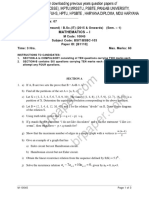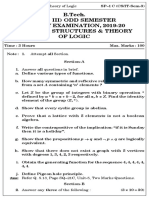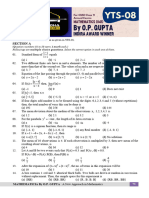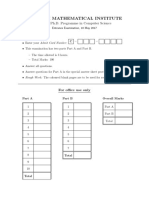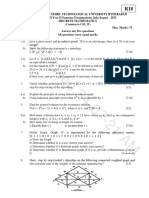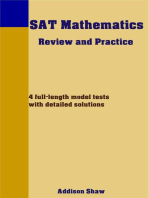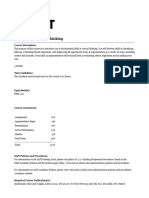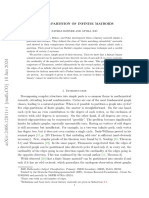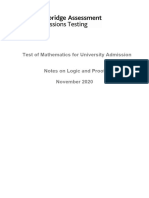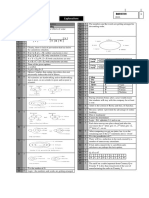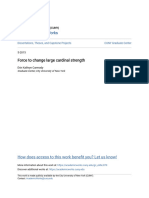Aux 2017
Aux 2017
Uploaded by
Jashandeep SinghCopyright:
Available Formats
Aux 2017
Aux 2017
Uploaded by
Jashandeep SinghOriginal Title
Copyright
Available Formats
Share this document
Did you find this document useful?
Is this content inappropriate?
Copyright:
Available Formats
Aux 2017
Aux 2017
Uploaded by
Jashandeep SinghCopyright:
Available Formats
Roll Number:
Thapar University, Patiala
Department of Computer Science and Engineering
AUXILIARY EXAMINATION
B. E. (Second Year): Semester-I Course Code: UCS405
(COE/COEM/CAG/CML/ SEM) Course Name: Discrete Mathematical
Structures
July 25, 2017 Time: 3 Hours, M. Marks: 100
Note: Attempt all questions with proper justification. Assume missing data, if any.
Q.1 a) Determine whether the pair of graphs given in Figure 1 is isomorphic (5+5)
or not? If yes, exhibit an isomorphism. If not, give a suitable reason.
U U2 Vi
V
U3
(, U4
Us
Figure 1
b) Determine whether the directed graphs given in Figure 2 have an
Euler circuit or not. If yes, write the Euler circuit. If no, then determine
whether they have an Euler path. Write the Euler path if one exists.
a
Figure 2
Q.2 a) What is a ring? Mention the conditions necessary to be a ring. (6+4)
b) What do you mean by a monoid? Mention the conditions necessary to
be a monoid.
Q.3 Answer the following questions for the poset ({3, 5, 9, 15, 24, 45}, I ). (10)
a) Find the maximal elements.
b) Find the minimal elements.
c) Is there a greatest element?
d) Is there a least element?
e) Find all upper bounds of {3, 5}.
0 Find the least upper bound of {3, 5}, if it exists.
1/3
M
g) Find all lower bounds of {15, 45}.
h) Find the greatest lower bound of {15, 45}, if it exists.
Q.4 i) Let p and q be the propositions "Swimming at the New Jersey shore is (5+5)
allowed" and "Sharks have been spotted near the shore," respectively.
Express each of these compound propositions as an English sentence.
a) —'q b) p A q c) —7) v q d) p —) —iq e) --lq —> p
ii) Let p and q be the following propositions
p :You drive over 65 miles per hour.
q :You get a speeding ticket.
Write the following propositions using p and q and logical connectives
(including negations).
a) You do not drive over 65 miles per hour.
b) You drive over 65 miles per hour, but you do not get a speeding ticket.
c) You will get a speeding ticket if you drive over 65 miles per hour.
d) If you do not drive over 65 miles per hour, then you will not get a
speeding ticket.
e) Driving over 65 miles per hour is sufficient for getting a speeding
ticket.
Q.5 Write the name of rule of inference used in each of the following (10)
arguments.
Also mention the rule using propositional variables clearly stating the
statements those propositional variables represent.
a) Alice is a mathematics major. Therefore, Alice is either a mathematics
major or a computer science major.
b) Jerry is a mathematics major and a computer science major.
Therefore, Jerry is a mathematics major.
c) If it is rainy, then the pool will be closed. It is rainy. Therefore, the pool
is closed.
d) If it snows today, the university will close. The university is not closed
today. Therefore, it did not snow today.
e) If I go swimming, then I will stay in the sun too long. If I stay in the sun
too long, then I will sunburn. Therefore, if I go swimming, then I will
sunburn.
Q.6 Show that if A and B are sets, then (5+5)
a)A—B=An B.
b) (A n B) u (A n B)= A.
Q.7 Suppose that g is a function from A to B and f is a function from B to C. (5+5)
a) Show that if both f and g are one-to-one functions, then f o g is also
one-to-one.
2/3
•
4
r
b) Show that if both fand g are onto functions, then f o ,g is also onto.
Q.8 Find big-0 estimate for the following functions: (10)
a) (n log n + n2)(n3 + 2)
b) (n! + 2n)(n3 + log(n2 + 1))
Q.9 A parking lot has 31 visitor spaces, numbered from 0 to 30.Visitors are (5+5)
assigned parking spaces using the hashing function h(k) = k mod 31,
where k is the number formed from the first three digits on a visitor's
license plate.
a) Which spaces are assigned by the hashing function to cars that have
these first three digits on their license plates: 317, 918, 007, 100, 111,
310?
• Q.10
b)Use linear probing to resolve collisions in part a). Find new spaces
assigned to cars after resolving collisions.
Let S be the subset of the set of ordered pairs of integers defined (4+6)
recursively by
Basis step: (0, 0) E S.
Recursive step: If (a, b) E S, then (a, b + 1) e S, (a + 1, b + 1) E S, and (a + 2,
b +1) E S.
a) List the elements of S produced by the first four applications of the
recursive definition.
b) Use structural induction to show that a 2b whenever (a, b) E S.
3/3
You might also like
- Full Chapter Fuzziness in Information Systems How To Deal With Crisp and Fuzzy Data in Selection Classification and Summarization 1St Edition Miroslav Hudec Auth PDFDocument54 pagesFull Chapter Fuzziness in Information Systems How To Deal With Crisp and Fuzzy Data in Selection Classification and Summarization 1St Edition Miroslav Hudec Auth PDFeric.snyder678No ratings yet
- DM Question BankDocument7 pagesDM Question BankSCAM 1992No ratings yet
- CM1020 RevisedDocument7 pagesCM1020 RevisedDouglas CaiafaNo ratings yet
- B4 2-R3Document23 pagesB4 2-R3api-37825190% (1)
- Discrete Mathematical Structures Dec 2010Document2 pagesDiscrete Mathematical Structures Dec 2010Prasad C MNo ratings yet
- Mathematical Foundation of Computer Science Jan2007 r059210502Document10 pagesMathematical Foundation of Computer Science Jan2007 r059210502Nizam Institute of Engineering and Technology LibraryNo ratings yet
- Sample Question TEE - 2023Document2 pagesSample Question TEE - 2023afeidmszwNo ratings yet
- 160.102 Linear Mathematics - Massey - Exam - S2 - November 2010Document6 pages160.102 Linear Mathematics - Massey - Exam - S2 - November 2010DonNo ratings yet
- Chennai Mathematical Institute: M.Sc. / Ph.D. Programme in Computer ScienceDocument5 pagesChennai Mathematical Institute: M.Sc. / Ph.D. Programme in Computer ScienceRashmi SahooNo ratings yet
- r059210502 Mathematical Foundation of Computer ScienceDocument11 pagesr059210502 Mathematical Foundation of Computer Scienceprakash.paruchuri100% (1)
- Dis Maths Final Assignment Sec ADocument3 pagesDis Maths Final Assignment Sec AKirti AroraNo ratings yet
- 133BC052019Document3 pages133BC052019krishnaNo ratings yet
- 160.102 Linear Mathematics - Massey - Exam - SEMESTER ONE 2018 - Remove MetaDocument10 pages160.102 Linear Mathematics - Massey - Exam - SEMESTER ONE 2018 - Remove MetaDonNo ratings yet
- Math (1st) May2018Document3 pagesMath (1st) May2018ImranNo ratings yet
- DM Question BankDocument7 pagesDM Question Banksubhu04012003No ratings yet
- Final ExamDocument5 pagesFinal ExamceliomNo ratings yet
- 3 DMGT Assignment Questions 30-10-2023Document3 pages3 DMGT Assignment Questions 30-10-2023chcharan779No ratings yet
- BSC Computer Science WWW - Alagappauniversity.ac - in Alagappa University Model Question Paper DistDocument32 pagesBSC Computer Science WWW - Alagappauniversity.ac - in Alagappa University Model Question Paper DistradhasubbuNo ratings yet
- MC11 06Document6 pagesMC11 06Executive BoyNo ratings yet
- 2012 ASL Math - StatDocument10 pages2012 ASL Math - StatArborgerNo ratings yet
- DSTL Paper 2019-20Document3 pagesDSTL Paper 2019-20Dhruv TomarNo ratings yet
- Set A DMDocument2 pagesSet A DMNeeraj BaishwarNo ratings yet
- WWW - Manaresults.Co - In: Mathematical Foundations of Computer Science (Com. To CSE, IT, ECC) II B. Tech I SemesterDocument4 pagesWWW - Manaresults.Co - In: Mathematical Foundations of Computer Science (Com. To CSE, IT, ECC) II B. Tech I SemesterJ.vamshi KrishnaNo ratings yet
- Graph Theory & Combinatorics Jun 2010Document2 pagesGraph Theory & Combinatorics Jun 2010Prasad C MNo ratings yet
- Bca Question Paper PDFDocument4 pagesBca Question Paper PDFdrharpreet singh100% (1)
- 160.102 Linear Mathematics - Massey - Exam - Semester TWO - November 2006Document6 pages160.102 Linear Mathematics - Massey - Exam - Semester TWO - November 2006DonNo ratings yet
- DM - S2023 (3140708) (GTURanker - Com)Document3 pagesDM - S2023 (3140708) (GTURanker - Com)yrdhameliya627No ratings yet
- ML A1 PDFDocument3 pagesML A1 PDFshyamd4100% (1)
- MSC 2014Document567 pagesMSC 2014Alexis Black0% (1)
- Namma Kalvi 10th Maths Unit Test Question Papers em 216879Document16 pagesNamma Kalvi 10th Maths Unit Test Question Papers em 216879mickyNo ratings yet
- DMS - Question - Bank SDFDocument6 pagesDMS - Question - Bank SDFSyed Yousuf AliNo ratings yet
- Annual Math QP_11-2023Document7 pagesAnnual Math QP_11-2023meetjaswani876No ratings yet
- Graph Theory & Combinatorics July 2011Document2 pagesGraph Theory & Combinatorics July 2011Prasad C MNo ratings yet
- Math1081 2016 S1Document6 pagesMath1081 2016 S1ChristopherNo ratings yet
- 1-B SC (Maths)Document22 pages1-B SC (Maths)Prashant GuptaNo ratings yet
- HKCEE AMath 1999 Paper 1 deDocument21 pagesHKCEE AMath 1999 Paper 1 deLin Wing HoNo ratings yet
- YTS-08 (XI Maths Sample Paper - O.P. GUPTA)Document5 pagesYTS-08 (XI Maths Sample Paper - O.P. GUPTA)Sahil0% (1)
- Iii SemDocument20 pagesIii Sempriyasumbria46No ratings yet
- CC6 Class Test (AB-Sir)Document2 pagesCC6 Class Test (AB-Sir)Amitava Biswas AB SirNo ratings yet
- Chennai Mathematical Institute: M.Sc. / Ph.D. Programme in Computer ScienceDocument7 pagesChennai Mathematical Institute: M.Sc. / Ph.D. Programme in Computer ScienceRishi DeyNo ratings yet
- Ma6566 DM Iat IDocument2 pagesMa6566 DM Iat IInfi Coaching CenterNo ratings yet
- 1 CS201 - Discrete - Computational - Structures - QP PDFDocument3 pages1 CS201 - Discrete - Computational - Structures - QP PDFvoxovNo ratings yet
- 1 Cs201 Discrete Computational Structures QPDocument3 pages1 Cs201 Discrete Computational Structures QPvidhya_bineeshNo ratings yet
- L, M, K, Q: Answer Any Four QuestionsDocument4 pagesL, M, K, Q: Answer Any Four Questionsal_badwiNo ratings yet
- JulyAugust 2021Document1 pageJulyAugust 2021pallesirisha40No ratings yet
- Discrete Mathematics Question PaperDocument3 pagesDiscrete Mathematics Question PaperRajkumar RaazNo ratings yet
- Cse 4 Sem Discrete Mathematics and Graph Theory Winter 2018Document4 pagesCse 4 Sem Discrete Mathematics and Graph Theory Winter 2018pwasu12350No ratings yet
- November 2007 MathsDocument5 pagesNovember 2007 Mathsmunyaradzimutingwende02No ratings yet
- Lab 05 StudentssheetDocument7 pagesLab 05 Studentssheetaoora6No ratings yet
- Graph TeoryDocument3 pagesGraph TeoryVijaykumar ChiniwarNo ratings yet
- Discrete Mathematics Question PaperDocument4 pagesDiscrete Mathematics Question PaperRajkumar Raaz0% (1)
- Bca Dca BSC 1 Sem Mathematics 1 10045 Jan 2023Document2 pagesBca Dca BSC 1 Sem Mathematics 1 10045 Jan 2023rohitsalooria12No ratings yet
- MCS 2121Document5 pagesMCS 2121saurav NepalNo ratings yet
- 21R05NOV10Document26 pages21R05NOV10YCRNo ratings yet
- Class 11 - Mid Term Exam 2023Document4 pagesClass 11 - Mid Term Exam 2023keshavgoel241No ratings yet
- Faculty of Engineering: Code No. 11419 / CBCSDocument5 pagesFaculty of Engineering: Code No. 11419 / CBCSadsddvsNo ratings yet
- Question PaperDocument69 pagesQuestion Papergayathrisheshadri14No ratings yet
- TCS PrintDocument8 pagesTCS Printमनीष सिंहNo ratings yet
- Logic ModuleDocument44 pagesLogic Modulejeraldine gumpalNo ratings yet
- Phil 241 OverviewDocument5 pagesPhil 241 OverviewLaVida LocaNo ratings yet
- Logic Gates NotesDocument7 pagesLogic Gates NoteschirebvutawandaNo ratings yet
- Logic Answer KeyDocument4 pagesLogic Answer KeyBeniah LyNo ratings yet
- Module 1 PDFDocument169 pagesModule 1 PDFzubair7862mallikNo ratings yet
- COR 005 General Mathematics Review QuestionsDocument4 pagesCOR 005 General Mathematics Review Questionscarltabar75No ratings yet
- Digital System (Full PDFDocument150 pagesDigital System (Full PDFAmit RajputNo ratings yet
- Course 1Document6 pagesCourse 1ilyesinfo6No ratings yet
- Ccet2 Ai-1 2.5 UnitsDocument15 pagesCcet2 Ai-1 2.5 Unitsnavanithi4737No ratings yet
- Circuit-Partition of Infinite MatroidsDocument11 pagesCircuit-Partition of Infinite MatroidsKeshavKasichenulaNo ratings yet
- Module4 Set TheoryDocument19 pagesModule4 Set TheoryTeresilleNo ratings yet
- Assessment 7 - Attempt ReviewDocument6 pagesAssessment 7 - Attempt Reviewtaki.tshivhengaNo ratings yet
- Ai Set 1 MainDocument58 pagesAi Set 1 MainEranilde OseiNo ratings yet
- DD&CO Lab Manual (BCS302)Document19 pagesDD&CO Lab Manual (BCS302)swatikammar60No ratings yet
- Qa Logic and Set TheoryDocument8 pagesQa Logic and Set Theoryalagonmiles06No ratings yet
- T03 Predicate LogicDocument3 pagesT03 Predicate LogicNur SanjidaNo ratings yet
- TMUA Notes On Logic and Proof 2020Document69 pagesTMUA Notes On Logic and Proof 2020jimmyNo ratings yet
- Answers CET - 01Document4 pagesAnswers CET - 01ojas4911No ratings yet
- Cape 2022 Unit 1 p032 Pure Math QPDocument10 pagesCape 2022 Unit 1 p032 Pure Math QPSolomon ThomasNo ratings yet
- Basic Laws of Arithmetic, Volumes I & II: Derived Using Concept-Script Philip A Ebert Download PDFDocument53 pagesBasic Laws of Arithmetic, Volumes I & II: Derived Using Concept-Script Philip A Ebert Download PDFfjalarburuk100% (3)
- Assignment#2Document3 pagesAssignment#220230551No ratings yet
- Assignments AI THDocument4 pagesAssignments AI THMayank SainiNo ratings yet
- Mth202 Grand Quiz by JunaidDocument45 pagesMth202 Grand Quiz by Junaidmuhammadsamran1672No ratings yet
- Assignment 1 WMDocument1 pageAssignment 1 WMJia XuanNo ratings yet
- Lab Report 5Document6 pagesLab Report 5moslahuddin2022No ratings yet
- Discrete Mathematics (Module - II)Document35 pagesDiscrete Mathematics (Module - II)Shreya AgrawalNo ratings yet
- DLD Question BankDocument5 pagesDLD Question BankHarshad ThiteNo ratings yet
- Force To Change Large Cardinal StrengthDocument86 pagesForce To Change Large Cardinal StrengthnusretcerenNo ratings yet
- Bài tập thầy sơnDocument16 pagesBài tập thầy sơnnguyengiang011003No ratings yet













